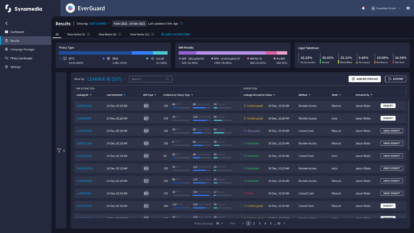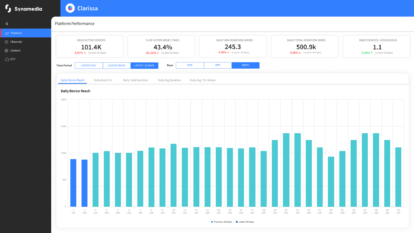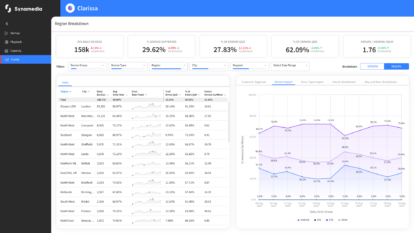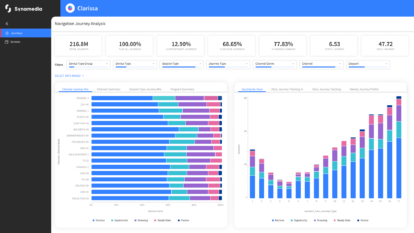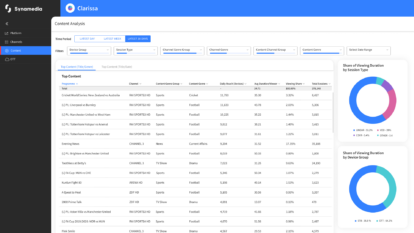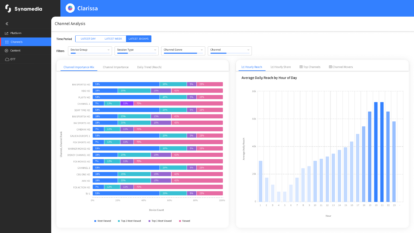Historically, advertising has relied on scale. The biggest brands happily spent millions to reach the massive audiences watching events like the Super Bowl and the Olympics. After all, a pool that big is statistically likely to include a large number of potential customers.
But this ‘spray and pray’ method is far less effective when scaled down for smaller budgets. Non-primetime audiences won’t stick around for the spectacle of irrelevant ads in the middle of a show they’re half-watching – they’ll change the channel. This is why advertisers have largely begun to turn to online advertising instead of traditional television advertising.
But this exodus isn’t inevitable. As a TV provider, you’ve got reach that digital alternatives can only dream of. If you combine that reach with the data richness that online advertising offers, you won’t just keep up with the digital world – you’ll offer something better.
In this article, we explore how broadcasters can harness the data they already have to deliver a better advertising environment for their advertising partners — and, crucially, for their viewers.
Combine the best of broadcast and online with addressability
TV providers like you have a tightrope to walk. You want to capture and hold viewer attention with your content, to entice advertisers to pay for your ad slots; but you also need to ensure the ads shown are relevant enough that your audience doesn’t decide to simply switch channels.
Advertisers already know they need to offer targeted ads in order to capture the attention of potential customers. But, in the world of TV, that’s always been easier said than done.
Traditional TV advertising is fairly broad and surface-level in its scope, limited largely by legacy broadcast technology. Advertisers can attempt to personalise their ads by limiting views to specific regions (as a proxy for location and demographics) or channels (in the hopes it broadly reflects viewer interests), but the overall process is very hit-or-miss.
Online advertising, by comparison, seems like a data-driven advertiser’s dream. Ads can be highly personalised — tailored to browsing activity and demographics — which means scale is less important. And ad interactions are also more measurable and immediate than is possible with traditional broadcast advertising, which depends largely on imprecise sampling panels.
But today’s TV providers also have a wealth of data at their fingertips — collected by the medley of connected devices used by today’s viewers.
Collected and used correctly, this data can be transformed into valuable insights — allowing providers to pinpoint precise household demographics and viewing patterns, identify the best ways (and times) to serve targeted ads to these audiences, and report accurately on viewer engagement and ad reach.
Done right, insight-led addressable TV advertising can give you the best of both worlds, combining the laser-targeted focus of online advertising with the extensive reach of TV. And, unlike online ads, TV ads can’t be auto-hidden with handy browser extensions.
So, what can you improve about addressable advertising with data insights behind you?
In short, almost anything. Video data analytics and insights opens up a new world of opportunities for providers to connect advertisers with the right audiences. Here, we’ll explore some of the big ways data insights can enhance your advertising capabilities and, subsequently, grow your advertising revenue.
- Get to know and reach your audience better with machine learning
The big draw of online advertising has always been its richness of data and accessibility. But advances in machine learning mean that insights from your video data can match digital insights pound for pound.
You can already get a rough representation of your viewers by analysing your holistic viewership data (which includes the type of content people are consuming and their viewing patterns).
But machine learning takes this several steps further. With it, you can uncover patterns that would be otherwise impossible to recognize — segmenting viewers by identifying their consumption preferences for specific genres and programs, the time of day they tune in, where they do so from, and what their favoured devices are.
This allows you to provide more granularity and increasingly nuanced targeting — which doesn’t just help you improve your own service for your viewers; it’s also a big draw for advertisers.
- Improve campaigns by accurately measuring ad impressions and viewer interactions
All the addressability in the world won’t mean anything to advertisers if you aren’t able to provide accurate measurements that allow them to validate ad impressions and improve future marketing campaigns.
And having this information helps you too.
For example, if you know that viewers are scrubbing or channel-hopping during ads, that tells you that you might need to further refine your viewer profiles or optimise the placement of your ad breaks. (A few well-timed ad breaks are better than several ill-thought-out ones.)
Having a unified, insight-driven solution — that helps you manage your inventory, assets, planning, and segments — will ultimately enable you to deliver a better, less disruptive experience for your audience. Additionally, your advertisers will be able to run more efficient, successful campaigns.
- Boost your advertising revenue with true addressability and smarter ad delivery
By delivering ads that connect with your viewers, you can boost your revenue while improving viewer engagement. And by segmenting your audience into more granular cohorts, you can target and measure responses in much greater detail.
You can also make your back catalogue work for you in a way it’s never done before. Older content tends to have dedicated viewer bases with specific tastes and interests. Using video insights, you can identify who’s watching your content, predict what other things they might be interested in, and market advertising opportunities to your partners based on this information. Viewers are also more willing to stick with an ad-supported service if the ads are relevant.
Applying these insights to addressable advertising opens the door to opportunities for growing your revenue. By providing advertisers with targeted audiences and accurate measurement, you can sell more spots for higher rates and back it all up with a rich set of insights.
Capture more value from your viewing audience
Synamedia can help you boost your advertising business by using modular cloud services to deliver the in-depth insights you need to implement true data-powered addressability.
Through our recently launched Synamedia Clarissa, we are bringing a unique kind of intelligence to the table, delivering insights that segment and characterise your audiences while accurately measuring response and reach.
Using Synamedia Iris, our dedicated addressable advertising solution, we can also help you to leverage those insights to target and deliver ads for broadcast and OTT viewers, all in one unified workflow
It’s time to unlock the potential hidden in your data.
Find out more:
About the Author
Amruta joined Synamedia in April 2020 to lead the company’s data and analytics initiatives, bringing data-driven insights to customers.
Amruta has 15 years’ experience in delivering video solutions, most recently as head of data and analytics at YouView. Prior to this she was product manager at Voxbone where she was responsible for all customer-facing solutions and APIs.
Amruta started her career as a software developer at NDS and then spent five years at Cisco where she worked for the office of the Chief Strategy Officer defining the next-generation video strategy. At that time, Amruta was responsible for its big data and analytics offering. Then, as business lead for Cisco’s API task force for its video business unit, she handled all aspects of API offerings – from building a nascent developer community with content-centric app developers to working with the technical teams to deploy a robust TV API platform.
Amruta holds an MBA from London Business School.

